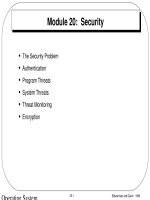Lecture Operating system concepts - Module 16
Bạn đang xem bản rút gọn của tài liệu. Xem và tải ngay bản đầy đủ của tài liệu tại đây (124.92 KB, 14 trang )
Module 16: Distributed-System Structures
•
•
•
•
•
Network-Operating Systems
Distributed-Operating Systems
Remote Services
Robustness
Design Issues
16.1
Silberschatz and Galvin
1998
Network-Operating Systems
•
Users are aware of multiplicity of machines. Access to
resources of various machines is done explicitly by:
– Remote logging into the appropriate remote machine.
– Transferring data from remote machines to local
machines, via the File Transfer Protocol (FTP)
mechanism.
16.2
Silberschatz and Galvin
1998
Distributed-Operating Systems
•
Users not aware of multiplicity of machines. Access to remote
resources similar to access to local resources.
•
Data Migration – transfer data by transferring entire file, or
transferring only those portions of the file necessary for the
immediate task.
•
Computation Migration – transfer the computation, rather than
the data, across the system.
16.3
Silberschatz and Galvin
1998
Distributed-Operating Systems (Cont.)
•
Process Migration – execute an entire process, or parts of it, at
different sites.
– Load balancing – distribute processes across netowrk to
even the workload.
– Computation speedup – subprocesses can run
concurrently on different sites.
– Hardware preference – process execution may require
specialized processor.
– Software preference – required software may be available
at only a particular site.
– Data access – run process remotely, rather than transfer
all data locally.
16.4
Silberschatz and Galvin
1998
Remote Services
•
Requests for access to a remote file are delivered to the
server. Access requests are translated to messages for the
server, and the server replies are packed as messages and
sent back to the user.
•
A common way to achieve this is via the Remote Procedure
Call (RPC) paradigm.
•
Messages addressed t an RPC daemon listening to a port on
the remote system contain the name of a process to run and
the parameters to pass to the process. The process is
executed as requested, and any output is sent back to the
requester in a separate message.
•
A port is a number included at the start of a message packet.
A system can have many ports within its one network address
to differentiate the network services it supports.
16.5
Silberschatz and Galvin
1998
RPC Scheme Binds Client and Server Port
•
Binding information may be predecided, in the form of fixed
port addresses.
– At compile time, an RPC call has a fixed port number
associated with it.
– Once a program is complied, the server cannot change
the port number of the requested service.
•
Binding can be done dynamically by a rendezvous mechanism.
– Operating system provides a rendezvous daemon on a
fixed RPC port.
– Client then sends a message to the rendezvous daemon
requesting the port address of the RPC it needs to
execute.
16.6
Silberschatz and Galvin
1998
RPC Scheme (Cont.)
•
A distributed file system (DFS) can be implemented as a set of
RPC daemons and clients.
– The messages are addressed to the DFS port on a server
on which a file operation is to take place.
– The message contains the disk operation to be performed
(i.e., read, write, rename, delete or status).
– The return message contains any data resulting from that
call, which is executed by the DFS daemon on behalf of
the client.
16.7
Silberschatz and Galvin
1998
Threads
•
Threads can sen and receive messages while other operations
within the tasks continue asynchronously.
•
Pop-up thread – created on “as needed” basis to respond to
new RPC.
– Cheaper to start new thread than to restore existing one.
– No threads block waiting for new work; no context has to
be saved, or restored.
– Incoming RPCs do not have to copied to a buffer within a
server thread.
•
RPCs to processes on the same machine as the caller made
more lightweight via shared memory between threads in
different processes running on same machine.
16.8
Silberschatz and Galvin
1998
DCE Thread Calls
•
Thread-management:
create, exit, join, detach
•
Synchronization:
mutex_init, mutes_destroy, mutex_lock,
mutex_trylock, mutex_lock
•
Condition-variable:
cond_init, cond_destory, cond_wait,
cond_signal, cond_broadcast
•
Scheduling:
Setscheduler, getscheduler, setprio, getprio
•
Kill-thread:
cancel, setcancel
16.9
Silberschatz and Galvin
1998
Robustness
To ensure that the system is robust, we must:
•
Detect failures.
– link
– site
•
•
Reconfigure the system so that computation may continue.
Recover when a site or a link is repaired.
16.10
Silberschatz and Galvin
1998
Failure Detection – Handshaking Procedure
•
At fixed intervals, sites A and B send each other an I-am-up
message. If site A does not receive this message within a
predetermined time period, it can assume that site B has failed,
that the link between A and B has failed or that the message
from B has been lost.
•
At the time site A sends the Are-you-up? message, it specifies
a time interval during which it is willing to wait for the reply from
B. If A does not receive B’s reply message within the time
interval, A may conclude that one or more of he following
situation has occurred:
– Site B is down
– The direct link (if one exists) from A to B is down.
– The alternative path from A to B is down.
– The message has been lost.
16.11
Silberschatz and Galvin
1998
Reconfiguration
•
Procedure that allows the system to reconfigure and to
continue its normal mode of operation.
•
If a direct link from A to B has failed, this information must be
broadcast to every site in the system, so that the various
routing tables can be updated accordingly.
•
If it is believed that a site has failed (because it can no longer
be reached), then every site in the system must be so notified,
so that they will no longer attempt to use the services of the
failed site.
16.12
Silberschatz and Galvin
1998
Recovery from Failure
•
When a failed link or site is repaired, it must be integrated into
the system gracefully and smoothly.
•
Suppose that a link between A and B has failed. When it is
repaired, both A and B must be notified. We can accomplish
this notification by continuously repeating the handshaking
procedure.
•
Suppose that site B has failed. When it recovers, it must notify
all other sites that it is up again. Site B then may have to
receive from the other sites various information to update its
local tables.
16.13
Silberschatz and Galvin
1998
Design Issues
•
Transparency and locality – distributed system should look like
conventional, centralized system and not distinguish between
local and remote resources.
•
User mobility – brings user’s environment (i.e., home directory)
to wherever the user logs in.
•
Fault tolerance – system should continue functioning, perhaps
in a degraded from, when faced with various types of failures.
•
•
Scalability – system should adapt to increased service load.
•
Server’s process structure – servers should operate efficiently
in peak periods; use lightweight processes or threads.
Large-scale systems – service demand from any system
component should be bounded by a constant that is
independent of the number of nodes.
16.14
Silberschatz and Galvin
1998









